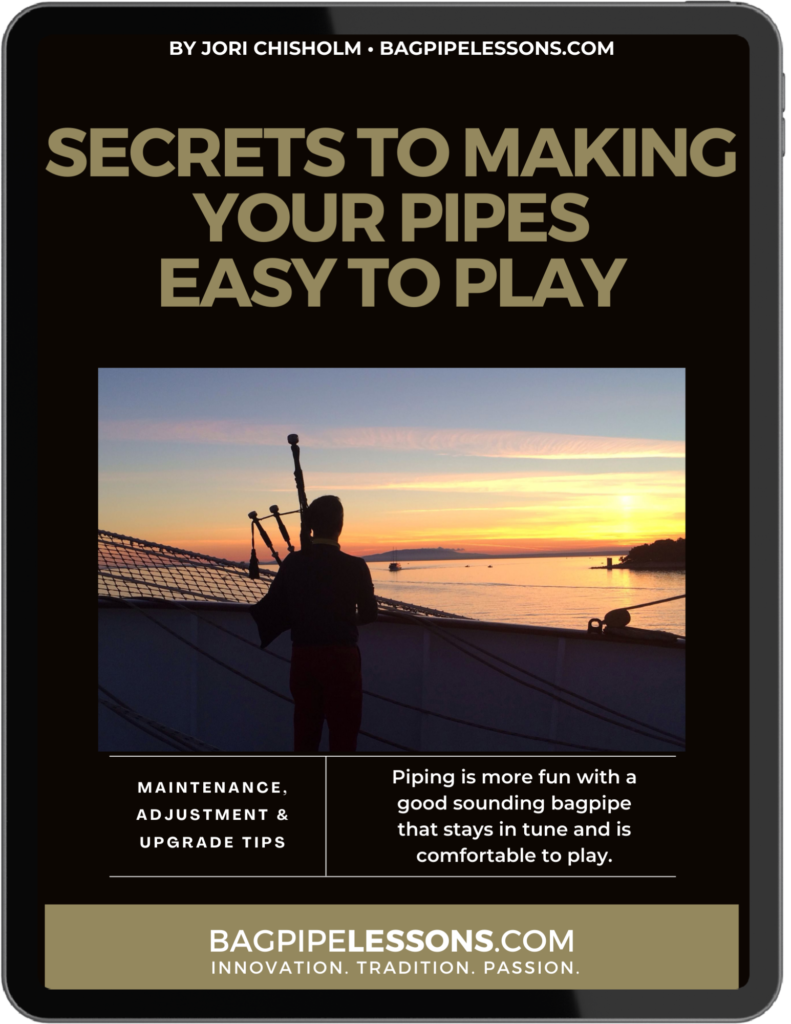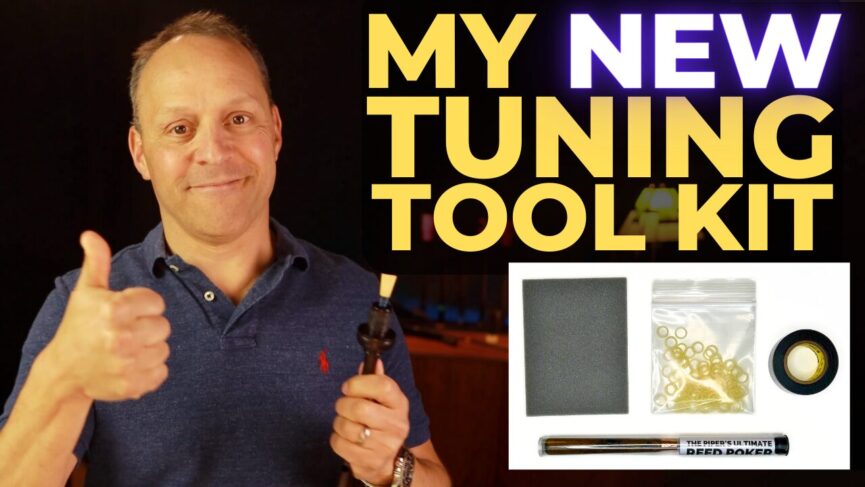
AS FEATURED IN

Live Bagpipes & AMA with Jori Chisholm: Donald MacLeod Tunes, Finger Warm-Up, Fixing Hard Reeds…
by Jori Chisholm, Founder of BagpipeLessons.com
Last Updated: June 14, 2024
In this live YouTube session, I share my insights, techniques, and personal experiences with bagpipes from my home studio. I begin with a performance, discuss equipment and tuning, and answer viewer questions, providing valuable tips for both novice and experienced pipers. I share my favorite tunes and their significance, highlighting the emotional and community aspects of music. Additionally, I provide practical advice on warming up, maintaining reeds, and ensuring consistent playability of the bagpipes.
Watch the video and scroll down to read a summary or the full video script.
Key Points
🛠️ Chanter Reed Tuning: Tuning the chanter reed to the right pitch (486 Hz) and using tools like the InTune Mic ensures precision.
💡 Favorite Tunes: My selection includes piobaireachds like “I Got a Kiss of the King’s Hand” and jigs like “Banjo Breakdown”.
🎶 Music’s Impact: The power of live music to connect people and enhance experiences is emphasized.
🖐️ Warm-Up Techniques: Warming up hands and fingers through massage, hot water, and gradual playing improves performance.
📏 Pressure Measurement: Using tools like the Bagpipe Gauge helps in maintaining the right pressure for optimal reed performance.
🔧 Reed Adjustments: Techniques for adjusting reeds, such as sanding and using elastic bands, ensure balanced sound across the scale.
🪕 Historical Tunes: “Susan MacLeod” is highlighted as one of the greatest bagpipe tunes, showcasing the evolution of bagpipe music.
🔍 Finger Technique: Keeping fingers close to the chanter and relaxed improves the consistency of strikes and overall playability.
🎛️ Chanter Tape Use: Proper use of tape on chanter holes is essential for maintaining tune and adjusting for environmental changes.
Summary
Chanter Reed Tuning: I detail my tuning process using the InTune Mic, achieving a pitch of 486 Hz, and adjusting for precision with a range of five cents.
Performance Overview: I perform several of my favorite tunes, including piobaireachds and jigs, and share their personal significance.
Music’s Emotional Impact: I reflect on the transformative power of live music, its ability to connect people, and the joy it brings to both the performer and the audience.
Warming Up: Practical tips for warming up hands and fingers, especially in cold conditions, include massage, hot water, and gradual playing.
Reed Maintenance: I emphasize the importance of maintaining and adjusting reeds for balanced sound, using tools like sanding pads and elastic bands.
Pressure Measurement: Using a pressure gauge like the Bagpipe Gauge ensures that the pipes are set to the right strength for efficient playability.
“Susan MacLeod” Tune: Highlighting its significance, I discuss the innovative aspects of this popular tune and its impact on me as a young piper.
Finger Technique: Tips for maintaining consistent finger strikes, especially for the B strike, by keeping fingers close and relaxed.
Chanter Tape: Proper application of tape on chanter holes is crucial for maintaining tuning, especially with changes in environmental conditions.
Video Transcript: Thanks for watching me live here on YouTube. I’m Jori. This is my little home studio where I usually talk about various bagpipe-related topics, products, and ideas. Today, I thought I would start off with a bit of playing just to see how it sounds. You can let me know what you think about how the sound is coming across. I’m sure there are some tricks to improve it. We’ve got a nice microphone here, so just getting it in the right position for piping is important. Maybe there are some tricks with YouTube to get the streaming better.
The whole time I was playing, I had my InTune Mic going, so it looked pretty good there. This is a new reed in my pipe chanter. It was a little stiffer than I wanted initially, but with the elastic band on it, it’s breaking in nicely. The pitch is nice and high. It’s not particularly warm here today, but it’s nice and high. Right now, it’s showing 486, which is maybe higher than usual, but that’s just where it’s dialing in. I’m really happy with that. I have the settings on my InTune Mic set to be in tune precision with a range of five cents. So, it’s got to be pretty close to being in tune there. I like the B a little bit flat. You see the B, the third one up, is slightly flat. I like that. And then I like the D very slightly sharp on the tuner and the high A a little bit flat. So, that sounded pretty good.
The tunes I played started off with the ground of “I Got a Kiss of the King’s Hand,” one of my all-time favorite tunes, one of my all-time favorite piobaireachds. Then I played the ground of “Too Long in This Condition,” another beautiful tune. I followed that with a couple of slow airs. The first one is Donald MacLeod’s “Tuning Prelude.” I learned that from Alasdair Gillies. That tune is not published anywhere as far as I know. The next tune is another Donald MacLeod slow air called “Angus G. MacLeod.” Then I went into some jigs, more Donald MacLeod tunes: “Banjo Breakdown,” “Glasgow City Police Pipers,” and then the jig arrangement of the 6/8 “Atholl Highlanders.”
My pipes are still warmed up, so I’m going to play a couple more tunes and then answer a few questions. If you have any comments and you’re watching live, throw them in the chat and I’ll answer them in a couple of minutes.
Cool, my pipes are feeling good. I’m going to cap them, though, and we can talk for a little bit. Someone suggested I should play “James McLellan’s Favorite.” I love that tune. Thanks, Daikon. I haven’t played that tune in a while. I’m going to work on it, though. I love that tune.
Okay, Tone Protector Chanter Cap, keeping it right at, is it going to focus? 86, yep, 84, 86, 82, somewhere in that range. And it’s my Infinity Chanter, Foundation Reed. I got my Atherton bagpipes with my Ezeedrones in there and a Bannatyne bag. So, I’ll put this over here for now. Cool, that was fun.
I’ve been thinking a lot about music in the last week or so. I went to an amazing concert last week in Seattle. It reminded me of the power of music and live music. I’ve been doing BagpipesLessons.com for 25 years. I’ve been playing the bagpipes since I was a kid, starting in 1987. Music has been a big part of my life in performing, writing, arranging, recording, and competing. But every time I go to see live music, it impacts me. This last concert was a great reminder of the wonderful, I don’t know, benefits isn’t quite the word, but just the wonderful ways music, listening to music, playing music, performing, and experiencing music live with other people is a huge part of it.
You can get caught up in the mechanics of learning, technique, memorization, and practice, trying to be good, and achieving goals. If you’re a competition piper, that can get into your head—wanting to win competitions and impress judges. It’s nice to be reminded once in a while of the transformative power and capacity of music to connect people and bring them together.
That’s why I thought I’d play today. I just felt like playing and didn’t have anything planned other than to just play some of my favorite tunes. The last tunes I played were the two-four march “Mrs. John McColl,” and then a hornpipe called “Aaron Campbell.” Aaron Campbell was a friend of mine, a fantastic world champion side drummer, and that tune was written by Adam Quinn, a great composer. Adam also wrote “The Blue Cloud,” which you may have heard, one of his most famous tunes.
Cool. Well, hopefully, this live streaming of the pipes came across okay. I’ll listen back to it when we’re done to see what the sound was like, and I’ll try to figure out if there’s anything we can do to make it sound better. I really like this idea of being able to play live, a sort of little online impromptu concert here. This is my house. I live here. BagpipeLessons.com is my business. It’s my home-based business. It’s been my passion for 25 years. Bagpipes have been my life, the number one thing apart from family, pretty much my whole life. So, this is my home. It’s my setup where I do my videos, teach my lessons, and practice.
So welcome, welcome in. We have a couple of questions here. Nancy asks, “Do you have a specific routine for warming up your fingers before you practice?” Sometimes I do. It depends on how my hands feel and how cold it is. If it’s cold, my hands get cold, and you lose some circulation and dexterity. So, your body will suck the blood in from your outer extremities into your core. If I’m warmed up, not a big deal, but if it’s cold, I’ll probably do some rubbing, like wringing out my hands. The hand getting the massage helps with blood flow, and the hand giving the massage gets a little workout. Another thing is to rub the forearms up to the elbows, limbering things up and getting blood flow.
Sometimes if I’m performing or competing somewhere cold, I’ll find a bathroom with hot water and run my hands under hot water for a couple of minutes. As hot as I can tolerate, just to get the temperature right and get blood to my hands. Then, just do some warm-ups. The first part of practice is warming up your body—all the blowing and squeezing muscles, arm, shoulder, back, diaphragm, lungs. You’re also warming up your instrument and your hands. Start with something simpler on the hands to get them warmed up. It’s also a process of getting your mind in the right mindset. Having your mind in the right mindset for practice is important.
I remember when I was playing with the SFU Pipe Band. That’s three hours north from here, from Seattle, to band practice up in Burnaby near Vancouver, Canada. Depending on the traffic, it’s three hours. You’re in your car, driving, and then it’s a transition. You’re in a different environment with people, doing something different. So, it’s a transition to get ready to practice with the group. The same thing when you’re playing at home. The hand massage, finger, and arm warm-up can be a way to transition from whatever you’re doing, whether it’s family, work, stuff around the house, or traveling, to get into that mindset.
JD says, “The high A seems to take a lot of breath and pressure for me to sustain. Is this normal?” It can be. If you mean normal as in good, no, it’s not something you would want. But is it normal as in common? Yes, it’s fairly common. It could be that your reed is too hard or not vibrating properly. It’s common where the strength is okay, but for the effort you’re putting in, it’s not producing much sound or any sound. You can have a reed where you’re blowing just as hard on the high A as on the low A, but there’s no sound coming out. That’s a reed issue. You may need to use a sanding pad to sand that reed. Watch my video about my Precision Tuning Tool Kit. It talks about the reed vibrating inefficiently and how to fix that with sandpaper. You might need a new reed. There are all kinds of reeds out there, and they’re handmade from cane, so every reed is different.
Here’s a Tone Protector Reed Case with a bunch of reeds in it. Even if you had a robot that made every reed exactly the same, which we don’t, they’re made by humans. But even if a robot or human could make every reed exactly the same in terms of dimensions and assembly, the reeds would still be different because the cane is different. Every piece of cane is a natural material from a plant growing out of the Earth, trying to reach the sun. Typically, instrument reed cane comes from France or Spain. A farmer cuts it down, dries it, ships it off. Your reed maker gets it, makes a reed. So, every piece of cane is different, every reed is different.
What you might want to do is measure the pressure of your pipes. The best way is with a pressure gauge, like my Bagpipe Gauge. You plug it in, and it’ll show you the pressure on your pipes. If it’s showing about 30, which is straight up and down, then your reeds are in the ballpark for the right strength. You have a little leeway if you prefer harder or easier. But if you find out you’re not getting any sound out of the high A unless you blow to 40 or 35, then it’s a reed problem. You may need to replace the reed, put an elastic band on it, or sand it a little. Some adjustment or replacement is needed for the high A to vibrate properly.
This reed I’ve got, I love it. I haven’t been playing it long, set it up just in the last week or so. I’m looking for a reed that’s the right strength for me. It was slightly harder than I wanted initially, knowing it will ease up. I want the reed to be efficient, meaning the effort I’m putting into it through blowing pressure, I want it to produce sound. When pipers talk about a balanced sound, sometimes people mean tuning. I wouldn’t use it to mean tuning. I would say if the reed is in tune, it’s tuned. Balanced means the volume and projection of the sound is similar across the entire scale. Sometimes you get a reed that’s very loud on the bottom hand notes, and as you go up, it gets quieter. We don’t want that. That would be unbalanced.
You’re looking for a chanter that has great projection, the volume it puts out is good for your effort, so it’s efficient and efficient all the way up and down the scale. That’s the reed, the chanter, and some things you can’t control, like how the reed is made and the quality of the cane. But some things you can control: you can adjust the strength by putting an elastic band on it, making it easier, poking the reed to make it harder, sanding the reed to ensure it’s vibrating properly and giving an efficient, balanced sound. Also, make sure the reed isn’t too dry or too wet. The Tone Protector helps with that.
Daikon says, “I just heard this bagpipe tune the other day called ‘Susan MacLeod.’ It’s such a great tune.” A lot of pipers consider that the greatest tune ever written. I was part of a Pipes Drums magazine expert poll. It was anonymous, but I was on a group of champion pipers or pipe majors. They asked, “What are, in your opinion, the greatest tunes of all time and the worst tunes of all time?” Then they published the results. “Susan MacLeod” came up as the greatest tune of all time. It’s hard to say what’s the greatest tune, like what’s the greatest Beatles song or the greatest piece written by Mozart. You can’t pick one, but there’s often agreement on a group of songs or tunes that are the greatest. “Susan MacLeod” is right up there. Beautiful melody, and there are some really interesting things about it that are innovative. The D doubling on a cut D is very unusual. The ending phrase is beautiful. It’s really the third part that does it for me.
I remember exactly where I was when I heard “Susan MacLeod” played for the first time. It was Colin Gammel, a piper from this area, playing at the Athena Highland Games in Athena, Oregon. I was a young boy, and I can just see him playing under this willow tree on the grass in the shade. He played “Susan MacLeod,” and it just stopped me in my tracks. I thought, what is that tune? That is amazing. The third part got me. We could talk about the tune for an hour. Amazing tune. Donald MacLeod, one of the best, put out six books of pipe tunes and maybe another book of piobaireachd tunes only. Super prolific, great piper of the 20th century.
“Do you have any tips for playing a more consistent B strike?” Yes. Don’t lift your fingers so high off the chanter. The B strike is tapping two fingers. It’s different than the E strike, which is one finger. F strike is one finger, high A is one finger, and C is two fingers, but you have this pinky helping you here with the B. Grab your chanter without playing. Play low G, play low A, and B. Watch my fingers: low G, low A, pinky comes up, B, ring finger comes up to meet the pinky. Most people raise the pinky for low A, and when they go to B, they raise the ring finger and raise the pinky even more. No good. Keep the fingers the same height and close. That will help keep your fingers relaxed.
Keeping your fingers close to the chanter and relaxed is important for all your technique, especially for the B strike. If you’re raising your fingers at different heights, you’re taking the pinky from outer space and the ring finger from the first floor, trying to have them hit at the same time. It’s much easier if they’re at the same height. Check that out and ensure you’re not hyperextending your fingers. A nice, relaxed, soft touch is what you’re going for. It’s common for people to raise the pinky higher, extending it. Keep it relaxed.
Nancy asks, “Tuning a chanter reed other than raising or lowering in the seat, how do you tune one with tape?” I got tape all over this thing. I just changed my tape earlier today. I have tape on every hole. Some have a lot of tape, like the D. Some don’t have much, like the high A. None on the low G, or a little bit on the low G. That’s how you tune it. Tape is great. I love tape because I love it when my chanter is perfectly in tune. The only way to get your chanter perfectly in tune is to get every hole perfectly in tune, and the way to do that is with tape.
Anyone who says there’s a platonic ideal gold standard of a chanter with no tape, nope. Doesn’t work that way. If you could get your chanter and reed perfectly in tune on every note without tape, which is doubtful, what do you do in 10 minutes when your F flattens? Or when you go outside, and the sun sharpens your high G? Then what? You need to adjust it. That’s why your drones slide up and down. We don’t glue them in place. Everything with the musical instrument is alive and changing, and you need to adjust. No big deal. Unless you play the piano in a concert hall with a technician who tunes it before you arrive, you’re tuning your instrument.
Dee says, “What’s attached to your pipe chanter?” Well, I’m not sure what you’re asking, but this is a Tone Protector Chanter Cap. It’s my humidity-controlling chanter cap, keeping things at 84% humidity. It doesn’t touch the reed, just goes over it. Maybe you’re asking about this foam piece. I’ve been experimenting with it for a few years. It allows me to have my thumb further away from the chanter, and it’s squishy. I want to make this a product people can buy. What I’ve discovered is having the thumb further out relaxes the hand. When I play without it, my hand is tighter. Having the thumb in here makes this muscle tighter. If you look at tools humans use, like steering wheels, ax handles, hammer handles, or bike handlebars, there’s a certain dimension that’s ergonomic. If you’ve ever driven a classic car with a hard, skinny steering wheel, you know it’s not as comfortable. Now we know softer, bigger around is better.
People have different preferences, but guitarists obsess over their gear, especially the shape and thickness of the guitar neck. It affects how your fingers feel and move. We pipers don’t think about it. We just get a chanter and that’s it. But maybe having it here is better for our hands. I’ve been experimenting with this, and I never want to play bagpipes without one of those on it. I have it on my practice chanter, my pipes, all my pipe chanters. I want to come up with a product that’s nicer than a piece of foam, something cool and adjustable.
A couple more questions here, then we’ll wrap it up for today. What’s the order of operations for taping a foam thumb pad to your pipe chanter so the tape you’re using doesn’t impact the tape covering the holes? Well, that’s tricky. Take all the tape off the holes, put the foam thing on, then tape your holes over it. Instead of wrapping around the chanter, it’ll go over the front of the hole and then on the sides of the foam. That’s why I want to come up with a slicker option.
Nancy says, “I’m brand new to putting the chanter in my pipes. Any tips for getting it lined up properly?” Thanks for the question. I don’t know what you mean by lined up properly. Do you mean how to get it in without breaking the reed, how to have it angled right, or how the chanter hangs when you’re playing? If you mean getting the reed in and out, be careful. Put your pipes down, lay them on a table. Don’t hold your bagpipes while sticking the chanter in. Lay the chanter down, take the tone protector off, and carefully put it in.
If you mean the rotation of the chanter in the stock, find the comfortable place and mark it. Have a little line on the chanter stock and the chanter itself. This way, you can rotate it and find the exact spot. You want to be able to put your pipes together and have it in the right spot every time. If it’s off, even a little, it can affect your playing. You might think you need a new reed, but maybe it’s just a little off. If you’re talking about getting your pipes set up for playing, use a mirror or a selfie camera. Try to get to a neutral position: shoulders down, head centered, chanter at a good height, forearms parallel or a little down, chanter pretty much in the center.
Thanks, everybody, for joining in. Peace out. Nancy, Daikon, JD, D, thanks for joining. Anyone watching the replay, post comments. I’ll try to do this throughout the summer. If you like the piping, say so, and I’ll do more of it. Check out BagpipesLessons.com, my shop, and BagpipesLessons.com/learn for free guides, videos, PDFs, and more. If you like this, subscribe to the channel and hit the bell to know when I do this again. Thanks, everybody. Have a great day, a great week. See you next time. Bye. Mahalo.
Okay, I think we’ll do one more question, and then we will wrap it up for today. Let you get on with your day, or if you feel like doing more piping, check out other videos on the BagpipeLessons.com YouTube channel.
Last question: My challenge is tuning the drones to the chanter. I have some hearing loss not related to piping, and when I believe my drones are tuned, they are not. Is there a method that works better than using a tuner?
Great question. There isn’t a better method than using a tuner because it’s an amazing tool. Let me grab my tuner here. The tuner does a couple of things. I’m talking about the Braw Bagpipe Tuner app. There are other tuner apps, but the Braw Bagpipe Tuner app is my favorite and the best. It works in conjunction with my microphone, the InTune Mic, along with the Tone Protector, my most popular and successful product.
The InTune Mic allows you to clip it right on your drone or chanter and isolate the sound of that component of your pipes to get it tuned. It connects wirelessly with your phone. This is why it’s such a big deal for pipers. There are great tuner apps, but the problem is practical: if you have your tuner sitting in front of you, it won’t work because you have four sounds coming from your pipes—the chanter and three drones. The only way the tuner knows what it’s listening to is if it can isolate one sound. You’d need the microphone built into the phone right next to the chanter or at the top of your drone, which is hard to do while playing.
The InTune Mic works by allowing you to place your phone wherever you want. You can mount it to your blowpipe with my Piper’s Advantage Bagpipe Phone Mount. Then, clip your InTune Mic wherever you need to tune. This setup only hears the specific drone or chanter, which works really well. People are super happy with it because you don’t need to have an ear for it or guesswork. It works even in noisy environments by isolating the sound.
Pipers have tuned their pipes by ear for generations, which does work but is a difficult skill that can take a lifetime to master. Even for experts, it can be impossible in noisy scenarios. With the InTune Mic and the Braw Tuner, you can tune your pipes at band practice or in noisy environments. This wasn’t possible before. The InTune Mic isolates the sound, much like if your ear was right up to the top of your drone.
If you want to tune your pipes by ear, that’s a great goal. The Braw Bagpipe Tuner and the InTune Mic make it faster, but you can still learn to tune by ear. The best way to learn is to use a tuner. The InTune Mic and Braw Tuner will get your pipes in tune quickly with precision, teaching you what in-tune pipes sound like. This helps train your ear over time.
The metronome does something similar. The Piper’s Metronome helps you play steadily at a specific tempo, with precision, so your embellishments come right on the beat. Practicing with the metronome develops your internal sense of timing. The bagpipe gauge also helps by showing your pressure, allowing you to improve steadiness instantly. The goal is not to always use these tools but to develop skills over time so you can perform well without them.
Before the iPhone and the Braw Tuner, I experimented with other tuner apps that helped develop my ear. People exposed to well-tuned musical playing from the start have a better musical ear. Being around well-tuned bagpipes, listening to recordings, and developing your tuning sensibility helps. Using a tuning device like the InTune Mic with your Braw Tuner helps you experience in-tune bagpipes, which improves your ability to tune by ear over time.
A challenge you can do: tune your pipes by ear, record it, then use the InTune Mic and Braw Tuner to check. You might discover that while your tenors are spot on, the bass needs adjustment. Over time, you’ll learn how to fine-tune your pipes by ear.
These tools are not a crutch but learning devices that accelerate your progress. Whether it’s the metronome, the bagpipe gauge, or the InTune Mic and Braw Tuner, each helps you immediately and trains you to improve over time. Experimenting with these tools will help develop your musical ear, and being around well-tuned bagpipes will enhance your tuning sensibility.
Do you have any tips for getting your name out there as a solo piper for gigs and live events? You just have to do a really good job. Marketing yourself well is important. Ensure any performance you do is great, whether it’s videoed, put on TV, or on YouTube. You should look sharp, your pipes should sound good, and you should play well. You don’t need to be a world champion, but for whatever level you’re at, be solid. Some pipers don’t prepare well, which can make pipers look bad. Always be ready and prepared with your tunes, tuning, and technique, and look sharp.
Lastly, someone asked about tips on learning the birl. The birl is a specific technique with multiple ways to play it. Most top players play the seven-birl because it’s the most reliable from every note on the scale. Other birls might be easier to learn initially, but they don’t sound as good and are less consistent. Check out my Bagpipe Essentials Masterclass at BagpipeLessons.com/masterclass. It has 31 detailed videos on every piece of bagpipe technique, including scales, gracenotes, GDEs, crossing noises, doublings, D throws, birls, taorluaths, and grips.
This Masterclass is free for members of my Inner Circle. If you’re interested in group classes, check out the Inner Circle at BagpipeLessons.com/membership. If you’re on YouTube, click subscribe and the bell icon to get notified when I go live or post new videos. This helps YouTube promote my videos to other pipers.
My BagpipeLessons.com Precision Tuning Tool Kit came out recently, and it’s selling well. Check out the Tool Kit for all your pipe chanter reed and tuning issues. Whether your reed is too hard, too easy, or the right strength but not vibrating fully, the Tool Kit will help.
Thanks, everyone, for tuning in. I think we’ll wrap it up there. Have a great day, and happy piping. Mahalo. Thank you.




